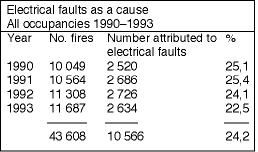
Electrical faults and the misuse of electrical equipment feature high on the list of fire causes in South Africa. Over the last four years just over 24% of fires have been attributed to electrical equipment or installations. Examples are:
* Lack of awareness, where incorrect or improper installations, equipment or hazardous situations are seen but not recognised.
* Carelessness, where existing or problem areas are recognised but ignored.
* Lack of maintenance.
* Blatant misuse, where unsuitable equipment is used or safety regulations and practices are totally disregarded.
The fire prevention policy of any organisation needs to take into consideration electrical fire hazards. Key questions to be answered when considering this include:
* Has the right equipment been provided?
* Has it been installed safely?
* Are precautions being taken with its use?
* Is it properly maintained?
Basic precautions are readily available and include:
* Motors.
* Transformers.
* Switchgear.
* Process heating.
* Comfort heating.
* Portable equipment.
Extracted from American legislation, the following information regarding temporary wiring and extension cords make useful guidelines and are worthy of inclusion in in-house fire safety standards:
Abatement of electrical hazards
* When any electrical hazards are identified, measures to abate such conditions shall be taken.
Extension cords
* Extension cords are not to be used as a substitute for permanent wiring.
* Extension cords are only permitted with portable appliances.
While in immediate use
* Each extension cord shall be plugged directly into the approved receptacle and except for approved multiplying extension cords, serve only one appliance.
* The current capacity of the cord must not be less than the rated capacity of the appliance.
* The cord must be maintained in good condition without splices, deterioration or damage.
* The cord must be of the grounded type when servicing grounded appliances.
* Extension cords must not be affixed to structure, extended through walls, ceilings, floors, under doors or floor coverings.
Temporary wiring
* Only permitted for power and lighting installations during the period of construction, renovation or demolition of buildings, structures or equipment.
* For other uses such as carnivals or the Christmas season, temporary wiring is only permitted for a maximum of 90 days.

Routine safety check
(A quick check that can be carried out daily or as required).
All equipment operating satisfactorily .
Employees trained to use equipment safely and to report faults.
Any signs of damage to cables and wiring.
Guards and shields to heating process in position and sound.
All thermal controls checked and tested regularly.
Indicator warning lamps operating satisfactorily.
Safety stands provided for soldering irons.
Distribution boards closed and in good repair.
All faulty equipment shut down immediately and reported.
Operators instructed not to tamper with equipment.
No unauthorised heaters in use.
No unauthorised adaptors introduced at socket outlets.
No unauthorised equipment where there are flammable vapours or explosible dusts.
At meal breaks and at the end of the working day:
* All machines/apparatus switched off.
* Portable equipment unplugged.
* Mains switches turned off.
* Equipment which has to be left on checked thoroughly.
Plant/equipment clean and clear of obstruction and combustibles particularly:
* Motors.
* Lighting.
* Heating equipment.
* Ovens/driers.
* Switchgear.
* Distribution boards.
References:
FPA (UK) Guide to safety with electrical equipment.
FPASA Bulletin No. 60.
SBCCI Standard Fire Prevention Code.

© Technews Publishing (Pty) Ltd. | All Rights Reserved.